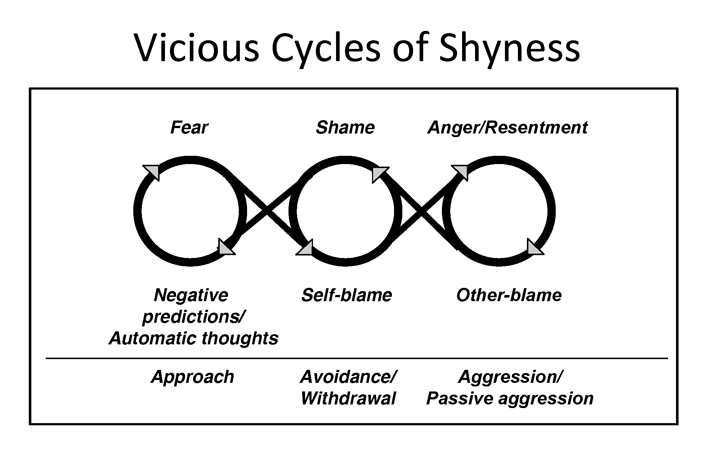Lynne Henderson, PhD, director of The Shyness Clinic—formerly known as the Stanford Shyness Clinic, where Philip Zimbardo developed revolutionary methords for treating problematic shyness-is the author of a new treatment guide, Helping Your Shy and Socially Anxious Client, that outlines an updated protocol for the treatment of social anxiety and shyness.
The social fitness model of shyness treatment is the product of twenty five years that Henderson has spent researching shyness and social phobia, updating and refining her treatment methods along the way. Social fitness is intended as an evolutionary metaphor, referring to adaptive responses to survival problems in the natural environment and to the functional nature of behavior, cognition, and emotion (Plutchik, 1997). It therefore addresses both the need for emotional connection and the importance of agentic responses in coping with one’s environment and life circumstances (Henderson, 2003; Horowitz, 2004). Like physical fitness, social fitness involves frequent social exercise, and there are many situations in which to practice. Just as one works out and participates in sports to stay physically fit, one remains socially fit by by being associated with groups and communities, meeting new people, cultivating friendships, maintaining close relationships, and developing intimacy with a partner (Henderson & Zimbardo, 2001).
The central idea of this approach is that social fitness, like physical fitness, is something that all of us can choose to improve at any time throughout our lives. Desired levels of social fitness likewise require a structured program of practice and exercise. In some cases, professional help (that is, qualified coaching) is desired or needed in order to achieve social fitness. Henderson asserts that shyness and social anxiety disorder need not be conceptualized as a debilitating condition or pathology. It may be seen as a suboptimal aspect of mental and emotional life that can be improved. The experience of shyness can be captured by the following three vicious cycles.
From Helping Your Shy and Socially Anxious Client, copyright © 2014 Lynne Henderson.
In the first cycle, as the shy individual approaches or anticipates a social situation, feelings of fear and negative predictions about the outcome of the social situation are prevalent. These feelings of fear and other negative cognitions increase the number of negative prediction about the social situation that, in turn, aggravate the already heightened level of fear. Avoiding the social situation may provide relief for the individual. However, feelings of shame and rumination take over such that the shy individual then feels shame for fearing and avoiding the social situation and moves on to the second cycle, where feelings of shame and self-blame abound. When a person experiences shame, other people may appear contemptuous. The shy individual therefore feels anger and resentment toward others and enters the third cycle. By blaming others, the shy individual reduces his or her feelings of self-blame and shame. Therefore, other individuals are seen as inconsiderate, unsupportive, uncaring, and so on.
Negative emotions and negative cognitions influence each other in an escalating, reciprocal pattern. Solutions to being socially “out of shape” may include exerting effort to effect changes in behavior, thinking patterns, and attitudes; “working out” in order to get in better “social shape”; or simply deciding to choose better-fitting social niches. Most people can attain a desired state of social fitness, just as most people can attain a desired state of physical fitness—if they are willing to put in the time and effort that will eventually and inevitably yield results.
In Social Fitness Training, individuals are empowered not only with the knowledge that they can take charge of their own behavior and have a choice in how they approach and deal with interpersonal situations, but also with the realization that for any given social situation, there are an infinite number of potential behavioral responses that can be considered appropriate or adaptive. Many individuals who undergo treatment for shyness and social anxiety disorder—and, more specifically, participate in Social Fitness Training—are surprised at how much they enjoy the activities and the resulting journey of self-discovery. This may sound familiar to anyone who has first resisted and then thoroughly appreciated the benefits of a physical-fitness regimen.
To learn more about the social fitness training model, check out Helping Your Shy and Socially Anxious Client: A Social Fitness Training Protocol Using CBT.
References
Henderson, L., & Horowitz, L. M. (1998). Estimations of Others Scale (EOS). Palo Alto, CA: The Shyness Institute.
Henderson, L., & Zimbardo, P. G. (2001). Shyness as a clinical condition: The Stanford model. In W. R. Crozier & L. E. Alden (Eds.), International Handbook of Social Anxiety: Concepts, Research, and Interventions Relating to the Self and Shyness. New York: John Wiley & Sons.
Plutchik, R. (1997). The circumplex as a general model of the structure of emotions and personality. In R. Plutchik & H. R. Conte (Eds.), Circumplex models of personality and emotions (1st ed.). Washington, DC: American Psychological Association.


 2024 Peace Playbook: 3 Tactics to Avoid Clashes with Your Partner
2024 Peace Playbook: 3 Tactics to Avoid Clashes with Your Partner